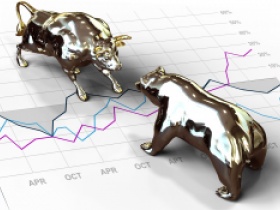Bull vs. Bear

May 09, 2021
How often have you heard the terms “bull” or “bear” used in the investing world to describe general actions, attitudes, or sentiment, either of an individual asset or the market conditions? As common as these terms are, defining, understanding, and remembering what they mean is not always very easy. Because the direction of the market is a major force affecting your portfolio, it is important that you know exactly what the more commonly used investment animal terms signify, how they are characterized, and how each one affects you.
In 2008, I visited Manhattan. As a banker, Wall Street was the tourist spot that was a priority on my list. What I remember most about Wall Street was how large and intimidating the massive 3-tonne iconic bronze sculpture known as the “Charging Bull” or “Wall Street Bull” located in the Financial District was. At 11 feet tall and 16 feet long, this aggressive animal is a tribute to power and prosperity. Is it any wonder, that this animal is used to symbolize a market that is on the rise and is economically sound?
There is more than one theory as to how these terms came about. The most popular theory of their origin also happens to be my personal favorite because once I learned that origin story, I never mixed the two up again. This story is that the terms came about because of how each animal attacks its opponents.
When a bull attacks, it lowers its head, and uses its horns to thrust its opponent up in the air. Hence, a bull market comes out of the market having been low, and then rapidly climbing. It is normally identified by a consistent increase in prices for it to merit the term “bull”. In such times, investors believe that the prices will continue to rise in the short to medium term. Typically, during a bull market, the country's economy is strong and employment levels are high.
On the other hand, when a bear attacks, it swipes its massive paws down, bearing down (pun intended) on its opponent with full force. Therefore, it makes sense that a bear market is one that plummets. In a bear market, prices are continuously dropping, resulting in a downward trend that investors believe will continue in the long run, which, in turn, perpetuates the spiral. During a bear market, the economy will typically slow down and unemployment will rise as companies begin laying off workers.
It is important to note that in a bull market, despite a general upward trend in prices, there will still be dips in prices. Likewise, in a bear market, prices will go up sometimes, and the result can lead to confusion as to whether you are in a bull or bear market. This is where trend analysis comes in.
But why a bull and a bear, when there are many other animals whose mode of attack are similar to the bull or the bear? The association of these two animals as famous opponents seems to have originated, at least in part, from gruesome matches using these two animals that began in medieval times around the 1200s and reached their height of popularity during the Elizabethan era. People would flock to the events and gamble on the outcomes, betting vast sums of money on a contest featuring a bull or a bear.
If nothing else, this explanation as to how the terms came about is certainly the easiest to verbalize and offers the most visual reasoning when trying to distinguish one term from the other. I bet, like me, you will not ever mix up these two terms, having heard this story! Just think of a bull thrusting up his head and a bear’s paw swiping down.
Toni-Ann Neita-Elliott, CFP is the Vice President, Sales & Marketing at Sterling Asset Management. Sterling provides financial advice and instruments in U.S. dollars and other hard currencies to the corporate, individual, and institutional investor. Visit our website at www.sterling.com.jm
Feedback: If you wish to have Sterling address your investment questions in upcoming articles, e-mail us at: info@sterlingasset.net.jm
